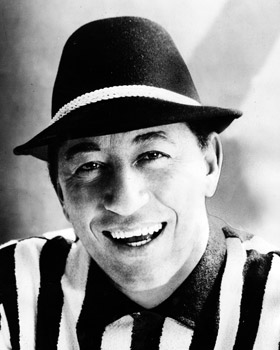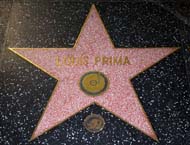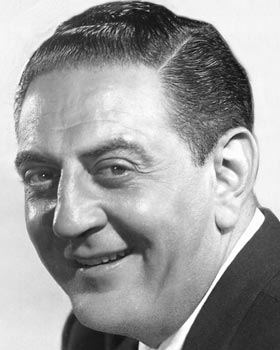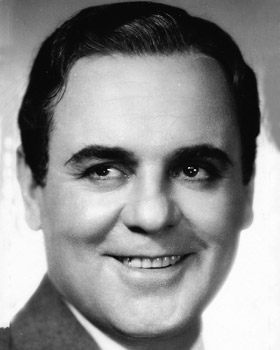Louis Prima
If ever there was a performer born and raised for the role, it had to be Louis Prima.
He came from first-generation Sicilian-American stock and was raised in New Orleans. He sang, played violin and horn as a child, and by his late teens Prima led a local seven-piece swing band. Spotted playing Dixieland jazz by band leader Guy Lombardo, Prima relocated at 22 to New York and formed a small group, Louis Prima and His New Orleans Gang.
Prima recorded extensively, but it was his wild stage presence that drew the most attention — he was a boisterous, goofball frontman and the act consisted of him singing and clowning around on stage. His biggest impact musically came with his 1935 composition “Sing, Sing, Sing,” an extended arrangement of which Benny Goodman performed live at Carnegie Hall in 1938 in what is considered the most influential big band recording ever made.
In 1939, Prima dispersed the gang and formed his own big band. He played standards, but was more at home interspersing his own compositions, tapping into his Italian background, “Angelina” was the biggest title, and joke songs.
But compared to other big band leaders Artie Shaw and Glenn Miller, Prima was not universally admired, seen more as a cartoony novelty act than a serious artist. However, even jazz writer Leonard Feather, not particularly an admirer, conceded that “for relentless animation, Prima is without equal.”
By the early 1950s, big band music was on the wane and Prima found himself out of fashion and broke. With few options and needing money, he got a gig at the Sahara casino in Las Vegas. It was a comedown, as Vegas lounges then were seen as cramped last stops for broken down old acts.
In 1953, he had married for a fourth time to Keely Smith, a woman half his age, who had been the singer in his band since 1948. In age and style they were opposites and Prima worked up an act to capitalize on the differences. It had Prima as his usual exuberant self, singing, scatting, strutting around while Smith, wearing her un-stylish black pageboy bob, stood off to the side, arms folded and a disdainful look on her face, not at all amused with his antics.
In Vegas, she was perhaps the only person who stayed unamused. Backed by a combo led by saxophonist Sal Butera, doing six nights a week, multiple sets a night that might end at 6 a.m., Prima and Smith were a hit.
They played a combination of jazz, pop, jump blues and New Orleans R&B. Prima’s uptempo material set the right tone for a late night in a smoky casino lounge: “Che la Luna,” “Just a Gigolo,” “Buona Sera” and, especially, “That Old Black Magic,” which in 1959 won them the first Grammy awarded for performance by a vocal group or chorus.
Either despite or because of their successes, Prima and Smith’s marriage was in trouble by the early 1960s. Part of it seems to have been rooted in professional jealousy — Prima had been the star, but Smith slowly began to eclipse him as a draw. Their act drew the attention of Frank Sinatra, but Sinatra wanted to sign just Smith to an album of ballads, and this, combined with marital woes, led to professional as well as personal divorce in 1961.
Prima married for a fifth time, to another singer, and stayed in Vegas, but rock 'n' roll was inexorably supplanting his style of music. A bright spot in 1967 came when he did the voice of King Louie the orangutan in Disney’s animated “The Jungle Book,” but otherwise he slipped to the sidelines and left Las Vegas for the road by the early '70s.
As brightly as Prima had burned as a performer through six decades, his presence abruptly vanished in 1975 — diagnosed with brain cancer, he suffered a cerebral hemorrhage after an operation to try and remove the tumor. He lapsed into a coma and stayed in that state until dying in 1978.
That could have been the end of the story, but the basic energy and infectiousness of Prima’s material continued to keep it in the public eye. A TV ad in the late '90s, using “Jump, Jive An' Wail” to sell pants, sparked a resurgence of interest and the attention of contemporary acts like Brian Setzer and Big Bad Voodoo Daddy who successfully toured with his material.
Meanwhile, Prima’s music continues to appear on TV episodes and movies. Black-and-white clips of the Prima/Smith duets of some of their top hits from the late 1950s have become staples on You Tube.
Related stars
|
|





One thought about Louis Prima
Share a thought about Louis Prima